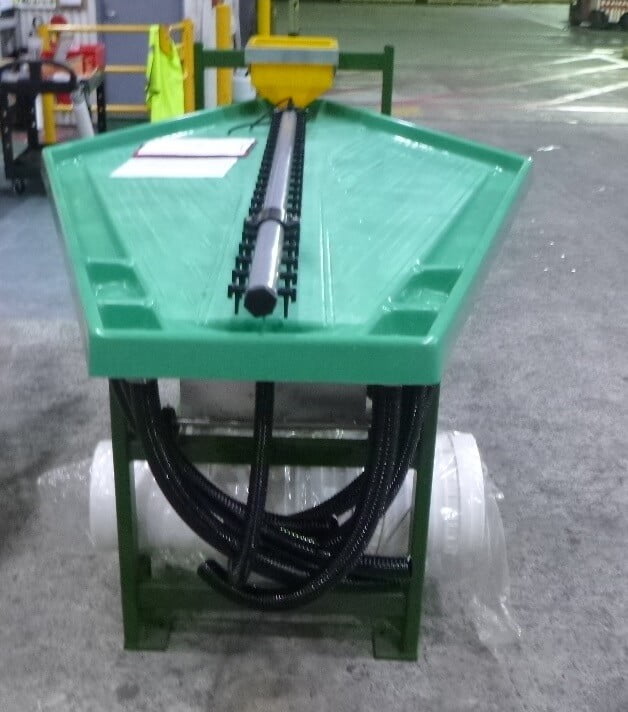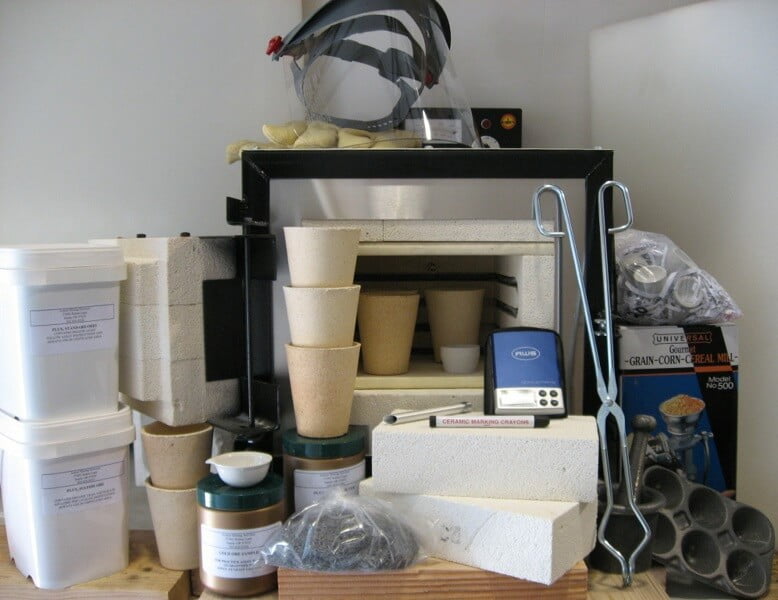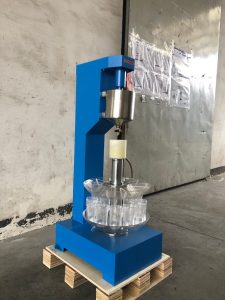Once the table set-up is optimized, lock all lock nuts on the driveshaft and bump-stop. Care must be taken not to change any settings when locking the locknuts.
Manifold Water Flow Setup
Controlling the water supply is extremely important. Set the main water valve about half open. Make sure the entire working area is wet. Adjust the flow from each ball valve until it creates a nominal 2cm ∅ water impact circle on the deck.
While separating gold, use the least amount of water necessary to keep the heavy minerals out of the clean gold pick-up grooves. In some cases where most of the gold is minus 75 µm you may wish to make a high-grade concentrate using the clean gold pick-up grooves. The middlings will contain some gold, which may be accumulated and reprocessed to obtain a very high-grade product.
Feed Setup
The feed rate, motion and water supply must be coordinated to suit the type of material being processed. A wet feed material of minus 850 µm is preferred for highest recovery of clean gold. The feed hopper has 1 height adjustment screw, and two locking clamps. To change the feed height, loosen the locking clamps and turn the height adjustment screw to suit new height, then tighten the locking clamps again.
Feed Size
Feed size less than 1.2mm (diameter) is recommended.
The elimination of iron particles from the feed using low-intensity magnetic separator is recommended
Feed Rate
Model 1000: Up to 450 Kg/hr
Model 250: Up to 120 Kg/hr
Model 60: Up to 30 Kg/hr
Ratings are based on processing typical placer concentrates. Head ore samples may often be processed at a much higher rate while very fine heavy minerals may require lower feed rates.
That is, when:
- Gangue minerals are predominantly of high specific gravity, (e.g. > 4.5 SG, various sulfide minerals etc).
- Feed sizing is predominantly fine, (e.g. < 300 µm). The optimum rate of feed should be established by testing during a processing run.
Finally
Finally, it is up to the operator to become acquainted with the various options available to get the maximum recovery for different applications. SLIGHT adjustments do make a BIG difference.
COMMISSIONING
With the motor isolated, perform the following checks:
- Is the Gemeni Table securely bolted down?
- Is the spring setup dimension correct & the locknuts tightened?
- Is the motor securely bolted to the frame?
- Check Electrical installation and earthing has been signed off by a qualified electrician in accordance with local
and/or statutory requirements
- Has the manifold water supply been connected?
- Is the Bump stop been positioned correctly? The locknut tightened?
- Is the Gemeni Table clear of any obstacles, walls, and located away from passageways and thoroughfares?
- Has all packing material been removed?
- Has the hopper feed outlet distance been set up correctly?
- Check gearbox oil level (refer section 11, “Motor & Gearbox”)
- Has all site regulations, including Occupational Health and Safety, been met?
If all the above checks have been successfully completed, then the machine may now be operated according to Operating Instructions.
GOLD SHAKER TABLE OPERATION
- Check that all buckets are in place, and with hoses leading to respective buckets.
- Start manifold water flow. Wait for the deck to be wetted thoroughly.
- Press Start to begin table movement.
- Add the feed to the hopper. Watch carefully how well separation occurs. It is up to the operator to become acquainted with the various options available to get the maximum recovery for different applications.
- Once the hopper has emptied and the mineral has been separated and depending on the degree of separation achieved, it may be worthwhile to reprocess the middlings (or other) fraction.
- After use, table deck motion can be turned off by pushing the “Stop” button.
- Any remaining minerals should be washed off the deck’s surface. Gently wash clean water down the table’s hoses to remove any mineral build-up.
- Turn water manifold supply off.
- Empty buckets.
GOLD SHAKER TABLE MAINTENANCE
For Gearbox maintenance, refer to attached literature under headings “Maintenance” and “Routine Maintenance”.
As Required
- Check-tighten locknuts on bump-stop and drive mechanism.
- Check manifold valves regularly for blockages. Clean out as required.
- Check the motor overload ensuring the current setting does not exceed the motor rated current.
- Lubrication in the gearbox is long life and does not require maintenance. If oil leakage occurs, rectify the source of leak and top up with Shell Omala 320 Synthetic Oil or equivalent (refer to section 11.1.)
Note: Do not use mineral oil.
- Check Drive Mechanism for broken springs.
- Check that the electrical motor air passages are clear from obstructions.
Weekly
• Check-tighten floor anchor bolts.
• Check deck surface. Remove any accumulated oils or grease with a very mild detergent and hose down with fresh
water. Any accreted build-up may be removed using fine wet and dry (1000 – 1200 grit) in conjunction with a flat
sanding block.
Monthly
- Lubricate motion bearings monthly and/or immediately following equipment hose down procedures.
- Use Shell Alvania – EP2 Grease or: SKF LG – EP2 Grease or equivalent
- Check-tighten all other bolted/screwed connections.
- Check gearbox oil level.
GOLD SHAKER TABLE REPAIRS
Paint Repairs
Repairs to the paintwork to be carried out as per “MT Paint Specification Wet Gravity Equipment” MT-OP-(SS)-ES2 – refer Part A.
Deck Repairs
Small depressions, nicks, etc. in the surface can be repaired by filling them with automotive filler and after drying, fine sanding back to the original surface. Larger depressions may interfere with the separation process (depending on the location).
Replacing Broken Springs
- Stop the machine and isolate power source.
- As per bump stop setting procedure, move the table manually to and fro until the eccentric inside the drive motion bearing is in the extreme backward position.
- Measure the distance from the bump stop to the striker plate. Record this dimension.
- Place suitable timber chocks between the bottom of the deck and the top of the frame which will stop the deck from moving once the driveshaft is removed.
- Loosen the lock nut on the bump stop and then wind the bump stop away from the striker plate as far as possible.
- The drive mechanism is held together by the drive shaft. Clean any dirt or grit stuck to the thread on the driveshaft.
- Loosen and back the locknut off the Adjusting bush by 5mm. Loosen the other locknut and spring adjusting nut, one at a time, away from the spring support bush by 40 to 50mm.
- Unwind driveshaft from Adjusting Bush. (If needed, stop Adjusting bush from turning by fitting a spanner across its flats).
- Now unwind all three (3) nuts off the driveshaft and put them aside.
- Remove first spring support bush, washer, and spring, then remove driveshaft with the remaining spring and bushes. Pull remaining spring, washer, and bushes off the driveshaft.
- Check drive shaft is straight and true. Both springs should be discarded. Install new springs as below.
Installing New Springs
- Check that you have all the correct parts required.
- Check that the timber chocks are in place to keep the deck from moving (refer to above).
- Place onto the driveshaft a washer, a spring support bush, a spring, and a spring retainer.
- Slide the driveshaft with the above parts through the hole in the steel plate attached to the underside of the deck (GT 1000 & 250), or through the hole in the rear rocker plate (GT 60).
- Now slide remaining spring retainer, spring, spring support bush, and washer onto the shaft. Fit the three (3) nuts to the shaft with the last nut approximately 50mm from the end of the drive shaft.
- Check that the spring support bushes and spring retainers are fitted correctly into the springs.
- Tighten the springs with the Spring Adjusting nut to the correct spring Assembly dimension.
- Wind the drive shaft into the adjusting bush until the rocker plates are vertical.
- Remove the timber chocks.
- Check the Spring Assembly dimension again. If the dimension is still okay and rocker plates vertical, then tighten one locknut against the adjusting bush and the other locknut against the Spring adjustment nut, taking care not to change any settings when tightening.
- Refer to table motion set up (section 5.1).
Replacing Bump Stop
- Stop the machine and isolate power source.
- Isolate water supply or close gate valve.
- Undo upper feed water hose clamp and pull off the hose from deck/manifold connection.
- Loosen Large height feed adjustment knobs and raise complete feed hopper assembly. Retighten.
- Follow steps 1-10 of section 8.3 (REPLACING BROKEN SPRINGS).
- Loosen and remove the fasteners from the top rear rocker bearings.
- Raise the end of the deck using suitable means (deck will pivot on front rocker plate) up approximately 100mm. Place timber chocks under to support.
- Check that the front locking nut is still locked tight.
- Grab the knob and twist to undo (twist knob anti-clockwise, looking at the knob from the feed end of the table). If the knob refuses to come off, then the knob can be cut off. Undo lock nut and unwind bump stop out. Remove lock nut.
- Thread lock nut onto new bump stop, then thread bump stop onto the deck. Check orientation is correct.
- Place some Thread locking compound (not supplied) on the thread of the knob and screw onto the end of the bump stop. Allow the compound to set before using.
- Lower the raised end of the deck down to allow for the top rear rocker bearings to be bolted to the deck.
- Now follow steps 1-11 of section 8.4 (INSTALLING NEW SPRINGS).
GOLD SHAKER TABLE TROUBLE SHOOTING GUIDE
Problem: Dry spots occur on Deck Surface.
Solution: 1. Flood the dry spot by hand or brush by pushing water upward on it.
2. Clean with a detergent to remove oils that may have accumulated.
Problem: Unwanted black sand enters gold pick-up grooves.
Solution: Increase water supply and/or decrease the amplitude (power of impact). Be sure base frame is level
lengthwise.
Problem: Thin flaky gold does not settle well and may be lost in the tailing discharge.
Solution: 1. Check each corner of base for any loose feet and secure if necessary.
2. Decrease the water volume at the feed end of the table.
3. Lower the rate of feed.
4. Check table motion setup.
Problem: Feed material does not exit the feed hopper evenly
Solution: 1. Check that the hopper outlet is square with the deck.
2. Feed one or both of the hoses connected to the top of the manifold into the hopper to reduce the density of the slurry.































